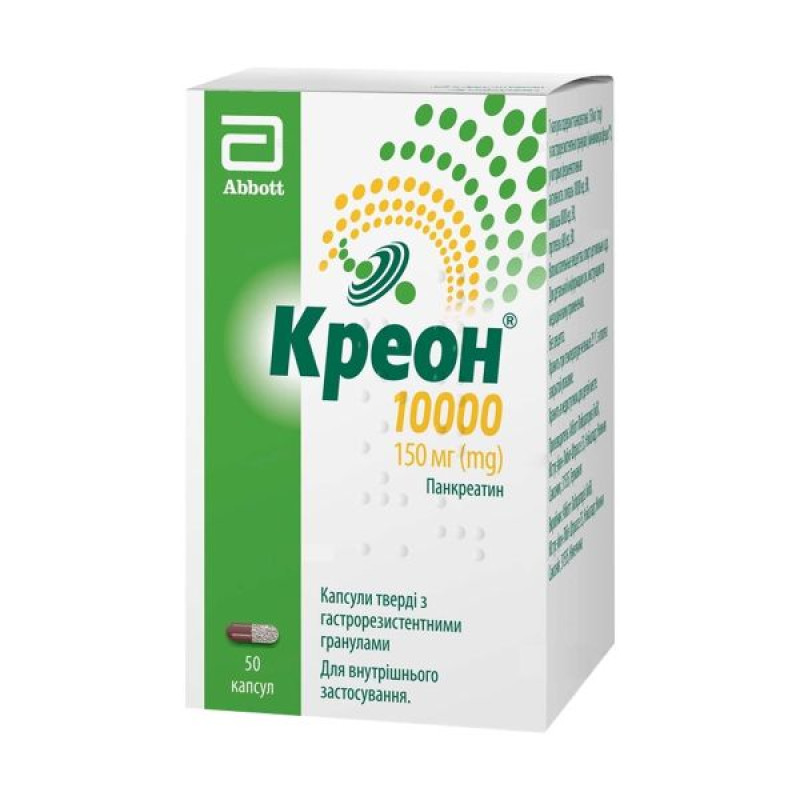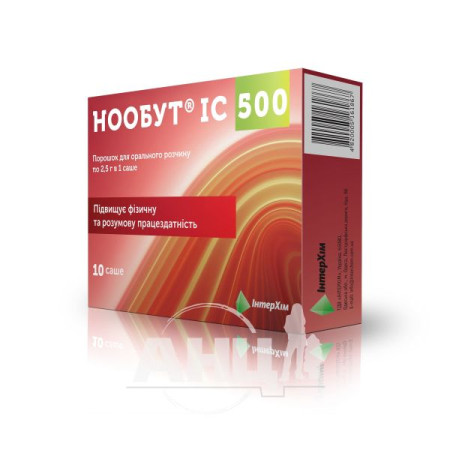Creon 10,000 hard capsules with gastro-resistant granules 150 mg blister No. 50

Instructions for use Creon 10,000 hard capsules with gastro-resistant granules 150 mg blister No. 50
Composition
active ingredient: pancreatin;
CREON® 10000: 1 capsule contains 150 mg of pancreatin in gastro-resistant granules (Creon minimicrospheres®), which have enzymatic activity: lipase 10,000 units EF, amylase 8,000 units EF, protease 600 units EF;
CREON® 25000: 1 capsule contains 300 mg of pancreatin in gastro-resistant granules (Creon minimicrospheres®), which have enzymatic activity: lipase 25000 units EF, amylase 18000 units EF, protease 1000 units EF;
CREON® 40000: 1 capsule contains 400 mg of pancreatin in gastro-resistant granules (Creon minimicrospheres®), which have enzymatic activity: lipase 40,000 units EF, amylase 25,000 units EF, protease 1,600 units EF;
excipients: macrogol 4000, hypromellose phthalate, cetyl alcohol, triethyl citrate, dimethicone 1000, hard capsule: gelatin, iron oxide (E 172), titanium dioxide (E 171), sodium lauryl sulfate.
Dosage form
Hard capsules with gastro-resistant granules.
Main physicochemical properties:
CREON® 10000 − two-tone hard gelatin capsules size 2 with a brown opaque cap and a colorless transparent body, filled with brownish granules (Creon minimicrospheres®);
CREON® 25000 − two-tone hard gelatin capsules size 0 with an orange opaque cap and a colorless transparent body, filled with brownish granules (Creon minimicrospheres®);
CREON® 40000 − two-tone hard gelatin capsules, size 00, with a brown opaque cap and a colorless transparent body, filled with brownish granules (Creon minimicrospheres®).
Pharmacotherapeutic group
Preparations that improve digestion, including enzymes. Polyenzyme preparations. ATX code A09A A02.
Pharmacological properties
Pharmacodynamics.
CREON® contains porcine pancreatin in the form of enteric-coated (acid-resistant) granules in gelatin capsules. The capsules dissolve rapidly in the stomach, releasing a large number of granules in a multi-dose manner, which ensures good mixing with the stomach contents, transport from the stomach together with its contents and, after release, good distribution of enzymes in the intestinal contents. When the granules enter the small intestine, the coating dissolves rapidly (at pH > 5.5), releasing enzymes with lipolytic, amylolytic and proteolytic activity, which ensures the breakdown of fats, carbohydrates and proteins. The products of pancreatic digestion are then absorbed either immediately or after further hydrolysis by intestinal enzymes.
Clinical efficacy.
A total of 30 studies of the efficacy of CREON® have been conducted in patients with exocrine pancreatic insufficiency (EPI). Ten of these were placebo-controlled. These studies included patients with cystic fibrosis, chronic pancreatitis, or postoperative conditions.
In all randomized, placebo-controlled efficacy studies, the pre-specified primary objective was to demonstrate greater efficacy of CREON® compared to placebo on the primary efficacy endpoint, the coefficient of fat absorption (COFA).
The fat absorption coefficient determines the percentage of fat absorbed into the body, taking into account fat intake and fat excretion in the feces. In placebo-controlled studies in patients with PAD, the mean CVD (%) was higher in patients taking CREON® (83.0%) compared to the placebo group (62.6%). In all studies, regardless of their design, the mean CVD (%) at the end of the CREON® treatment period was similar to the mean CVD for CREON® used in the placebo-controlled studies.
Treatment with CREON® significantly reduces symptoms caused by impaired exocrine pancreatic function, including stool consistency, abdominal pain, flatulence, and stool frequency, regardless of the underlying disease.
Children.
The efficacy of CREON® has been demonstrated in 288 children from newborn to adolescent age with cystic fibrosis. In all studies, mean CVD values at the end of the CREON® treatment period exceeded 80% in children of all age groups.
Preclinical safety data.
Non-clinical data do not indicate relevant acute, subchronic or chronic toxicity. No genotoxicity, carcinogenicity or reproductive toxicity studies have been conducted.
Pharmacokinetics.
Animal studies have not shown any evidence of absorption of the enzymes in their unchanged form, and therefore no classical pharmacokinetic studies have been performed. Pancreatic enzyme preparations do not require absorption to achieve their effect. On the contrary, their full therapeutic effect is manifested in the lumen of the gastrointestinal tract. Moreover, as proteins, they undergo proteolytic digestion as they pass through the gastrointestinal tract before being absorbed as peptides and amino acids.
Indication
Treatment of exocrine pancreatic insufficiency in adults and children caused by various diseases and conditions, including but not limited to the following:
– cystic fibrosis;
– chronic pancreatitis;
– gastrectomy;
– operations with the imposition of a gastrointestinal anastomosis (for example, Billroth II gastroenterostomy);
– Schwachman-Diamond syndrome;
– condition after an attack of acute pancreatitis and resumption of enteral or oral nutrition.
Contraindication
Hypersensitivity to the active substance or to any other component of the drug.
Interaction with other medicinal products and other types of interactions
Interaction studies have not been conducted.
Application features
In patients with cystic fibrosis who have received high doses of pancreatin, narrowing of the ileocecal part of the intestine and colon (fibrosing colonopathy) has been observed. As a precautionary measure, it is recommended to seek medical advice in case of unusual abdominal symptoms or a change in the nature of abdominal symptoms, to exclude the possibility of fibrosing colonopathy, especially if the patient is taking more than 10,000 units of EF lipase/kg/day.
Use during pregnancy or breastfeeding
Due to the lack of clinical data on the effects of pancreatic enzymes on pregnancy, the drug should be administered with caution to pregnant women. Animal studies have shown no evidence of absorption of pancreatic enzymes. Therefore, no toxic effects on reproductive function and fetal development are expected.
Since animal studies indicate no systemic exposure to pancreatic enzymes in lactating women, no effects on the breastfed infant are anticipated. Therefore, pancreatic enzymes can be administered to women during lactation.
If necessary, pregnant or breastfeeding women can take CREON® in doses sufficient to ensure adequate nutritional status.
Ability to influence reaction speed when driving vehicles or other mechanisms
The effect of CREON® on the ability to drive or operate other mechanisms is absent or negligible.
Method of administration and doses
The dosage of the drug is based on the individual needs of the patient and depends on the severity of the disease and the composition of the food.
It is recommended to take the drug during or immediately after meals.
Capsules and granules should be swallowed whole, without breaking or chewing, and washed down with sufficient liquid during or after meals, including a light snack. If the patient cannot swallow the capsule whole (e.g. children and elderly patients), it can be carefully opened and the granules added to soft food with an acidic environment (pH < 5.5) that does not require chewing, or to an acidic liquid (pH < 5.5). This can be applesauce or yogurt, or fruit juice with a pH < 5.5, such as apple, orange or pineapple juice. This mixture should not be stored. Breaking and chewing the granules or adding them to food or liquid with a pH > 5.5 may destroy their protective enteric coating. This may lead to premature release of enzymes in the oral cavity, as well as to a decrease in the effectiveness of the drug and irritation of the mucous membranes.
It is necessary to ensure that no drug remains in the oral cavity.
During treatment with CREON® 10000, CREON® 25000, CREON® 40000, it is very important to drink enough fluids, especially during periods of increased fluid loss. Fluid deficiency can worsen constipation. Any mixture of granules with food or fluids should be taken immediately and not stored.
Dosage for cystic fibrosis.
Based on the recommendations of the Cystic Fibrosis (CF) Consensus Conference, the US CF Association case-control study, and the UK case-control study, the following general dosing recommendations for pancreatic enzyme replacement therapy can be proposed:
- the initial dose for children under 4 years of age is 1000 units of lipase EF per kilogram of body weight during each meal and for children over 4 years of age – 500 units of lipase EF per kilogram of body weight during each meal;
- the dose should be selected individually, depending on the severity of the disease, control of steatorrhea and maintenance of adequate nutritional status;
- the maintenance dose for most patients should not exceed 10,000 units of EF lipase per kilogram of body weight per day or 4,000 units of EF lipase per gram of fat consumed.
Dosage for other types of exocrine pancreatic insufficiency:
- the dose should be selected individually, depending on the degree of digestive disorders and the fat content of the food. When taking a meal, doses from 25,000 to 80,000 units of EF lipase and half of the individual dose are necessary for a light snack.
Children
CREON® can be used in children.
Overdose
Cases of hyperuricosuria and hyperuricemia have been reported in association with extremely high doses of pancreatin.
Adverse reactions
In clinical trials, the effects of CREON® were studied in more than 900 patients. The most frequently reported adverse reactions were gastrointestinal, mostly mild to moderate in severity.
Gastrointestinal: very common (≥ 1/10) - abdominal pain*; common (≥ 1/100 to <1/10) - nausea, vomiting, constipation, bloating, diarrhea*; frequency unknown - narrowing of the ileocecal section of the intestine and colon (fibrosing colonopathy).
*Gastrointestinal disorders were mainly related to underlying disease. Diarrhea and abdominal pain were reported at a similar or lower frequency than placebo.
Skin and subcutaneous tissue disorders: uncommon (≥ 1/1000 to < 1/100) – rash; frequency unknown – itching, urticaria.
On the part of the immune system: frequency unknown - hypersensitivity (anaphylactic reactions).
Narrowing of the ileocecal part of the intestine and colon (fibrosing colonopathy) has been reported in patients with cystic fibrosis who have taken high doses of pancreatin preparations (see section "Special instructions").
Allergic reactions, mainly but not exclusively cutaneous, have been identified as adverse reactions during post-marketing use. As these reactions were reported spontaneously and from an uncertain number of patients, the exact frequency of these reactions cannot be estimated.
Children
No specific adverse reactions have been identified in children. The frequency, type and severity of adverse reactions in children with cystic fibrosis were similar to those in adults.
Expiration date
2 years. Shelf life after first opening is 6 months.
Storage conditions
Store at a temperature not exceeding 25 °C in a tightly closed container.
Keep out of reach of children.
Packaging
20 or 50 or 100 capsules in a high-density polyethylene bottle, 1 bottle in a cardboard box.
CREON® 25000, CREON® 40000: 10 capsules in a blister, 2 blisters in a cardboard box.
CREON® 10000: 10 capsules in a blister, 1 or 2 or 3 blisters in a cardboard box.
Vacation category
Without a prescription.
Producer
Abbott Laboratories GmbH, Germany.
Location of the manufacturer and address of its place of business
Justus-von-Liebig-Strasse 33, Neustadt, Niedersachsen, 31535, Germany.
There are no reviews for this product.
There are no reviews for this product, be the first to leave your review.
No questions about this product, be the first and ask your question.












